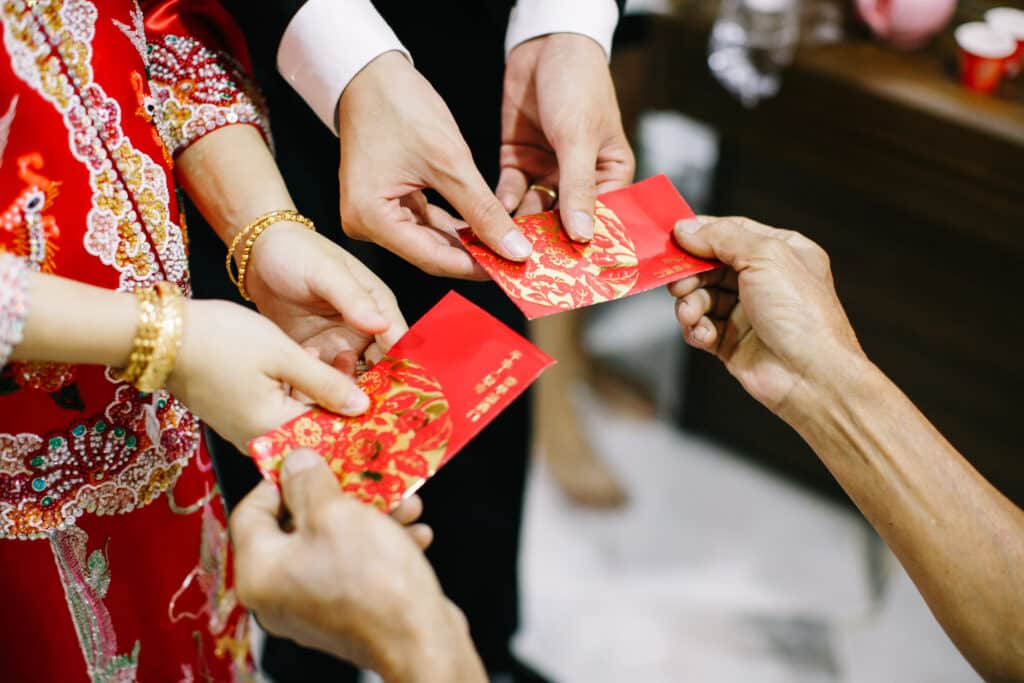Many children of Chinese expats recall going with their parents to the bank so they could send money home for Lunar New Year.
When I was much younger, my mom, Sally, now a retired accountant, would go to the bank to send money to my cousins living in Hong Kong for Chinese New Year. It was a fairly lengthy process, and my mom would sometimes grumble about it.
Luckily, it’s easier now to send monetary gifts for the Lunar New Year from Vietnam to China and beyond, thanks to the advent of digital red packets. It’s also usually cheaper, thanks to transfer apps like Remitly.
Let’s take a look at how people keep the gift-giving tradition alive with digital red packets and explore how you can send them this year.
Table of contents

Why do people send “lucky money” for the New Year?
Lunar New Year is a huge, multi-day festival and one of East Asia’s biggest holidays. Often called the Spring Festival, it marks the end of winter and ushers in a new year—the Year of the Dragon in 2024.
In Chinese culture, it means a fresh start.
It’s a time for honoring ancestors, feasting and exchanging gifts, and chasing away evil spirits while looking forward to the year ahead.
Elders also give younger family members money for good luck. This Chinese tradition, called “lucky money,” or hongbao in Mandarin, is symbolized by the red envelope.
Traditions vary from Shanghai to Beijing and throughout the region, from Tết in Vietnam to Seollal in Korea—the red envelope is famous regardless of the locale.
For instance, during Vietnamese New Year (Tết), families also give red envelopes. Elders give monetary gifts to younger people along with advice and words of wisdom. The lucky money in Vietnamese is known as li xi.
Nowadays, digital “red envelopes” have become more common. This is thanks to the rise of mobile wallets and mobile payment platforms like Vimo and MoMo in Vietnam and Alipay and WeChat Pay in China. In fact, China is the world’s largest mobile payment market.
If you can’t be with your loved ones to shower them with gifts or red envelopes, you can still send them virtual red envelopes. We’ll walk you through the steps to sending money for the Lunar New Year from overseas.

4 interesting facts about red envelopes
Receiving a beautiful red envelope is a highly anticipated part of the Chinese New Year festivities, and many customs have sprung up surrounding them. Here are a few of them.
The condition of the bills matters
Because they are meant to express good wishes for the year, the appearance of red envelopes matters. People are picky about the look of the envelope and want the notes inside to be crisp, clean, and fresh. As a result, you’ll often see long lines of people who want to trade old bills for new ones at banks.
They should be given and accepted with two hands
Reaching for things with one hand is considered bad manners in many Asian countries. As a result, it’s customary for the giver to hold the red envelope in both hands when presenting it and for the recipient to take it with both hands when accepting.
The amount of the gift can be significant
In Chinese traditions, some numbers are associated with good fortune, while we consider others unlucky. To convey best wishes, people may stuff red envelopes with amounts that include the number 8, like 80 or 800. Amounts with the number 4 are avoided because they’re thought to be unlucky.
Just as the fun of red envelopes has spread to other places like Hong Kong and Vietnam, the tradition of presenting an envelope filled with currency has been adopted by different cultures.
Across Southeast Asia, many people now give green envelope gifts to friends and family for the Islamic festival of Eid al-Fitr.
How to send a digital red envelope
Are you planning to give digital hongbao or li xi this year? Since the weeks leading up to Chinese New Year or Tết will be extremely busy, preparing in advance is a good idea.
My mom would go to the bank at least two weeks before the start of the holiday, so she had plenty of time. She’d tell my cousins to expect her gift by the first day of Chinese New Year.
Starting early helps you avoid delays. Depending on the country you’re sending digital red envelopes to, banks may close on the first day of the Lunar New Year—some close for multiple days following the official holiday.
Researching rates and fees
With all money transfers, you can expect to pay something either in fees, exchange rate markups, or both. If a company advertises a certain rate, look carefully at their fees—and vice versa.
Transfer fees can either be a flat rate, depending on the transfer method and final destination, or a percentage of the total amount sent.
Exchange rate markups will vary. Our guide to exchange rates will help you understand just how exchange rates are determined.
Choosing the right service for you
Cost isn’t the only consideration. I spoke to Lorelie L. about this, who sends money to her family living in the Cagayan Valley in the Philippines.
She focuses on the reputation of the money transfer service. One of her preferred methods is Remitly, for this reason.
“I used to receive money from my mom when I was still in the Philippines and it arrived quickly,” she says. “So, I trusted the company my mom chose and used them when it came time to send money to my grandparents for the holidays.”
In Lorelie’s case, she was looking for a service that was not only reliable but also fast.
While there may not be one company that ticks off all your desired qualities, look for one that will offer you the majority of what you want.
Using an app to send Lunar New Year Gifts
The COVID-19 crisis accelerated the growth of international transfer services. Once people discovered how easy and convenient it can be to make transfers virtually, they continued to rely on them even after pandemic restrictions ended.
Not only is sending with an app more convenient, but it tends to be faster. Just think of the time you’ll save driving to and from your home.
When you use apps like Remitly, you can easily see their fees and that day’s exchange rate. In most cases, it’s one of the cheapest ways to transfer money since digital companies tend to have less overhead costs.
Most of these apps will allow you to transfer money to Asian countries like China and Vietnam, but check before you create an account.
What information do I need to send a digital red envelope?
In all cases, you’ll need to include your name and address and your recipient’s full name and phone number. If you’re transferring to their bank account, you’ll also need details such as the account number and the name of the bank.
To use a money transfer app, you will also need your own debit or credit card information if you wish to fund the transaction with a card.
If sending to a mobile wallet, you generally need only your recipient’s name, phone number, and/or email associated with their digital wallet account.
For specific information about sending money to an Alipay mobile wallet in China with Remitly, check out our guide here. For a list of places you can send funds to Vietnam, see our page here.
Wishing you a Happy New Year
Make offerings to your ancestors. Set out peach and apricot flowers. Watch the CCTV Spring Festival Gala. Enjoy dumplings and sweet rice cakes. Whatever your traditions, it’s a great time to embrace a fresh start.
Happy New Year!
Frequently Asked Questions
A digital red envelope, known as “hongbao” in Mandarin or “lai see” in Cantonese, is a modern adaptation of the traditional Chinese new year red envelope. Traditional red envelopes, or money envelopes, are crafted from red paper and filled with an amount of money and given to family members, especially children, as a symbol of good luck for the coming year. Digital red envelopes are especially popular among those who can’t meet in person during the celebrations because they can be sent on messaging apps via smartphones.
In texting, a red envelope symbolizes good luck and prosperity. The act of sending a digital red envelope conveys well-wishes for the new year, and the red color represents joy and good fortune in many Asian cultures. Although red envelopes are popular during the new year, they can also be sent during other special occasions. For a Chinese American family, red envelopes serve as a powerful reminder of cultural heritage and family ties.
In Chinese traditions, some numbers represent good luck, while others are unlucky. To convey best wishes, people may stuff red envelopes with amounts that include the number 8, like 80 or 800. Amounts with the number 4 are avoided because they’re thought to be unlucky.
You’ll need to include your name and address and your recipient’s full name and phone number. If you’re transferring to their bank account, you’ll also need details like the account number and name
To use a money transfer app, you’ll need your own debit or credit card information.
If sending to a mobile wallet, you generally need only your recipient’s name, phone number, and/or email associated with their digital wallet account.
People want the notes inside to be crisp, clean, and fresh, so you’ll often see long lines of people who want to trade old bills for new ones at banks. Reaching for things with one hand is considered bad manners in many Asian countries. As a result, it’s customary for the giver to hold the red envelope in both hands when presenting it and for the recipient to take it with both hands when accepting.
Yes, it’s possible to send a virtual red envelope internationally. Many messaging apps and digital payment platforms allow users to send virtual red envelopes across borders. When sending a virtual red envelope internationally, the sender typically needs to ensure that both they and the recipient have accounts set up on the same platform. There may be currency conversion fees or restrictions depending on the service used and the countries involved. Overall, this modern adaptation of the red envelope tradition allows families and friends to share blessings and good wishes, regardless of distance.
Although sending virtual red envelopes are not a traditional practice, they’ve become more popular. Traditionally, members from the older generation would give red envelopes to younger kids. Today, however, red envelopes are given to friends, family, co-workers, and even casual acquaintances.
The exact origins are unknown, but there’s a story about a demon named “Sui” who would come and pat children’s heads while they were sleeping, scaring them and giving them fever. Parents would then try to keep their children awake all night on New Year’s Eve to protect them from Sui. One year, a child was given eight coins to play with to keep him awake, but he fell asleep with the coins on his pillow. When Sui appeared and tried to pat the child’s head, the coins produced a powerful light that scared him away. Legend says that the eight coins were the Eight Immortals in disguise, another important story in Chinese mythology.